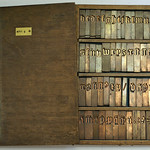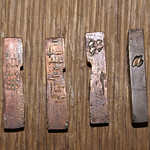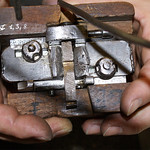(under construction)
As described in the introduction, the underlying hypothesis for this reserach is that Gutenberg and consorts developed a standardized and unitized system for ‘designing’ and casting Textura type, and that this system was extrapolated for roman (and later italic) type. Humanistic handwriting was literally molded into pre-fixed standardized proportions.

Pilot Parallel Pen 6 mm
In line with my predecessor and tutor at the kabk, Gerrit Noordzij, I consider writing a good starting point for exploring matters like construction, contrast-sort, contrast-flow, and contrast. Translating handwriting into type is not very straightforward though. Despite the fact that they are trained to work directly from their own writings, students often start to define grids before drawing letters. And usually they look at existing typefaces for the ‘correct’ proportions. Obviously patterning is a requirement for designing type and it is difficult to distill these patterns from handwriting. Could it be possible that type also find its origin in patterning besides in writing, and that this even influenced writing after the invention of movable type?

To do still
There seems to be no Humanistic handwriting predating movable type that shows such a clear standardization as roman type. My measurements of incunabula seem to prove that character widths were standardized during the Renaissance. The written Textura Quadrata made it relatively easy for Gutenberg and consorts to standardize and systematize their movable Gothic type. When this was accomplished, it was obvious to apply the same system to the new roman type (and decades later to italic type). The clear morphological relationship between Textura and Humanistic Minuscule made this possible.

To do still
The underlying structure of Textura Quadrata and Humanistic Minuscule made an organic standardization of the handwritten models possible. It was there all the time, but it wasn’t necessary to capture it so literally before movable type was produced. Also side bearings were a natural extension of the handwritten model. This standardization is captured in the dtl LetterModel (LeMo) application.

To do still
Nowadays it is common practice to design characters first and subsequently apply side bearings. It’s quite plausible that during the early days of typography the proportions and widths of the characters were defined first and subsequently the details were adapted to the widths.

To do still
As mentioned, the step from handwriting to type design is difficult. Even for me as an experienced calligrapher. I set up a calligraphy course for the Dutch television and wrote a book for it end of the 1980s. Noordzij was very positive about it in Letterletter 12 (June 1991): ‘Frank Blokland has succeeded in bringing the literature on calligraphy on a higher level; his book makes better reading and is a more reliable guide than any other book on the subject.’
The question is, how to combine the outcomes of my measurements with calligraphy in type education. Well, one can make a template with LeMo, like this one for a Pilot Parallel Pen 6 mm. In case of a translation over 30º, the stem thickness is pen-width x sin 60º = 0.87. The x-height here is five times the stem thickness; approximating what I measured in Jenson’s type.

To do still
Next one can use the template for tracing with a broad nib, trying to apply subtle details. The outcome can be auto-traced and converted into a font. As mentioned, spacing is part of the system, so the letters should form words automatically.

To do still
This basis can be used for further formalization and refinement. For digital type it is not necessary to standardize widths, of course. This clearly is different from what IMHO was required in the practice of the Renaissance punchcutter.

To do still

To do still
The past few days I found some spare time to transform the digitized handwritten letters into formal variants, using the original LeMo-based standardization. I tried to maintain the stem-interval and manipulated especially the lengths of the serifs to get an equilibrium of white space. This way for instance the n is measurably centered on its width; this preserves the equal distances between all stems. I believe that Jenson for this reason applied asymmetrical serifs to for instance the n. The o looks round, but is an ellipse and as wide as its handwritten origin.

To do still
For typesetting foundry type –specifically for the justification of lines– it is nice if the width of characters and spaces are defined in units. I applied here the most simple system, using the stem-thickness as value. The original spacing was just rounded to the grid.

To do still
The original character proportions are preserved here; the fitting becomes a bit tighter, but the word spaces in this case a bit wider (three units). So far in the whole process the character proportions and their widths were generated ‘artificially’.

To do still
Next one can double the grid for refinement.

To do still
And this process can be repeated.

To do still
A more refined grid also makes it possible to redefine the proportions of certain letters onto it. Here one enters the world of Kernagic, so that is another story.




